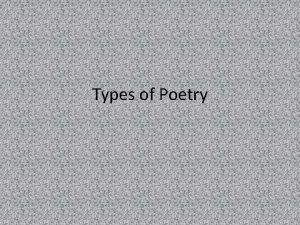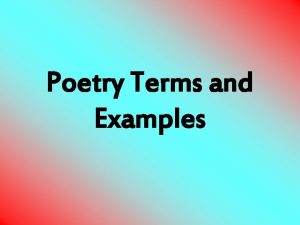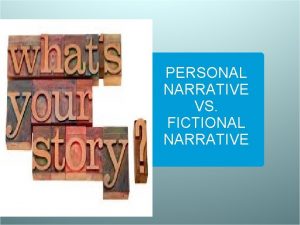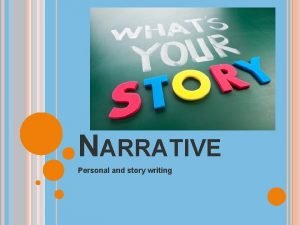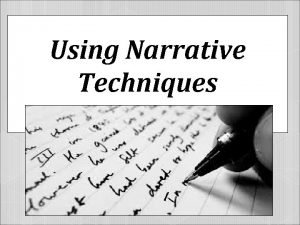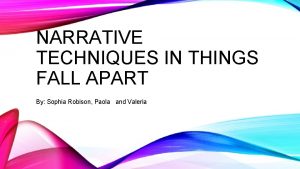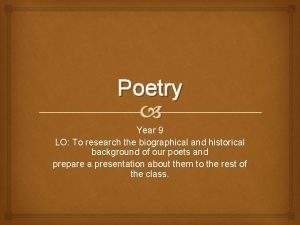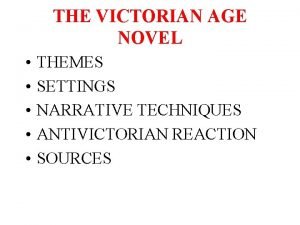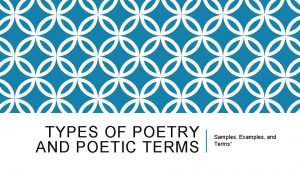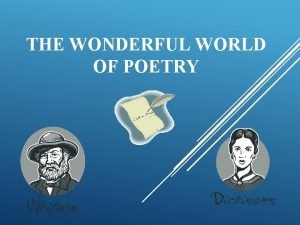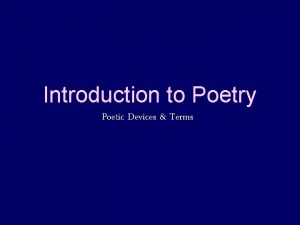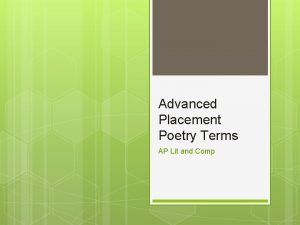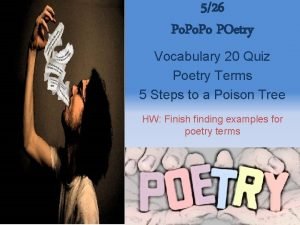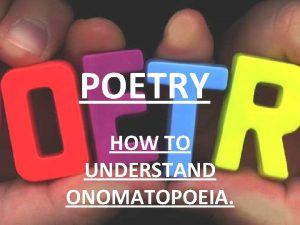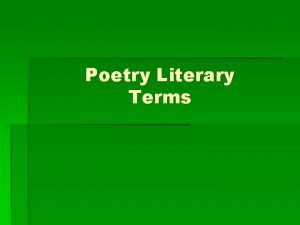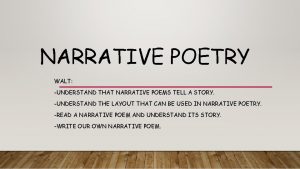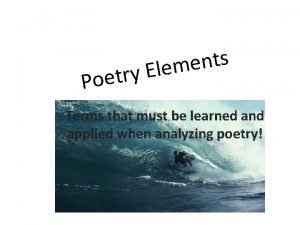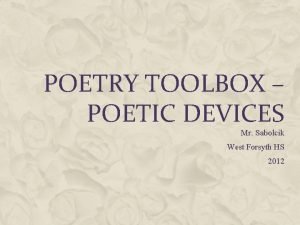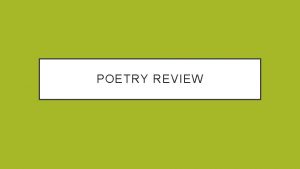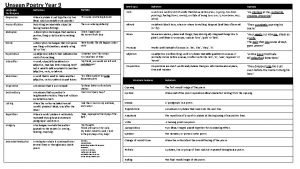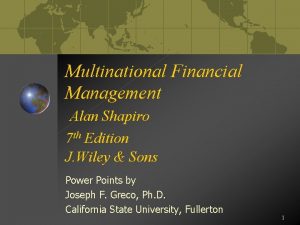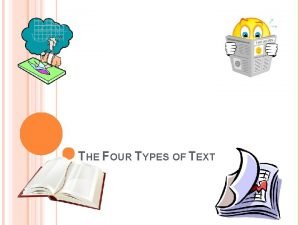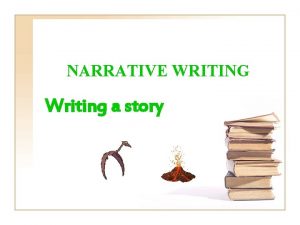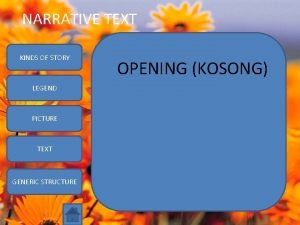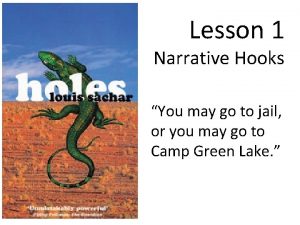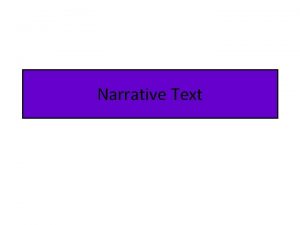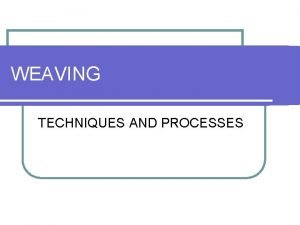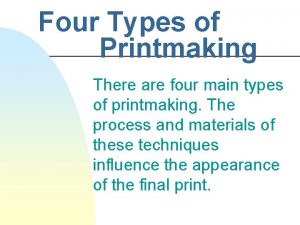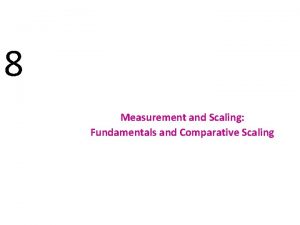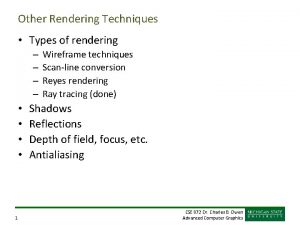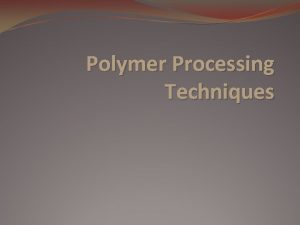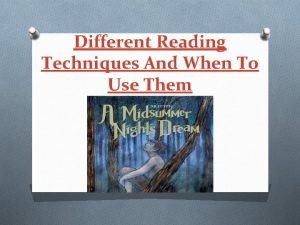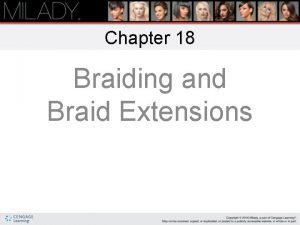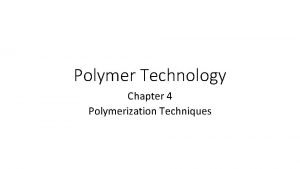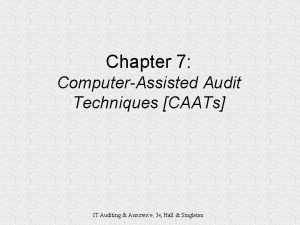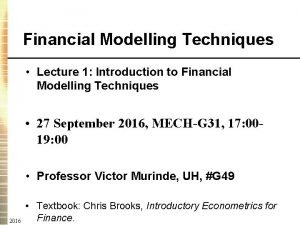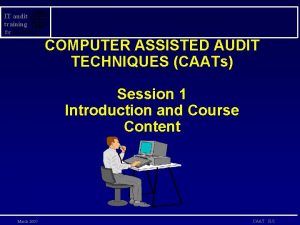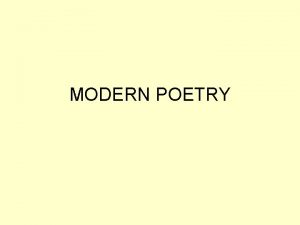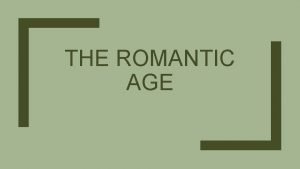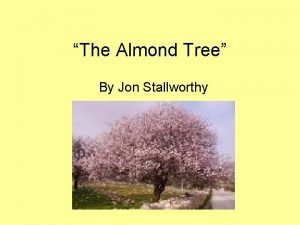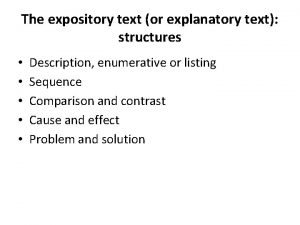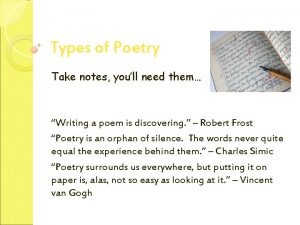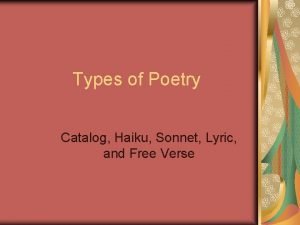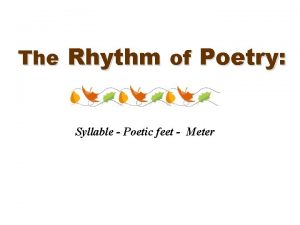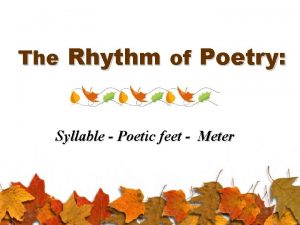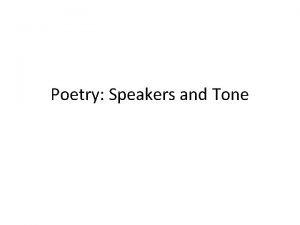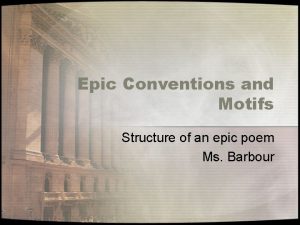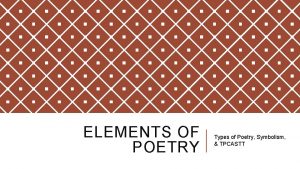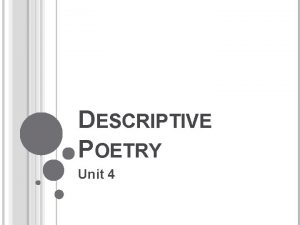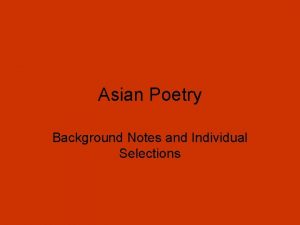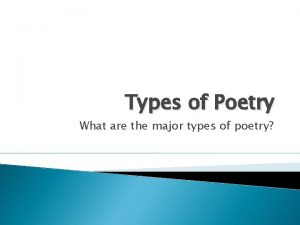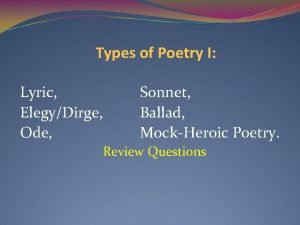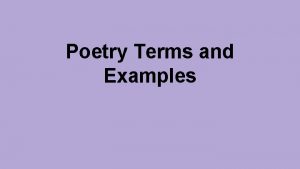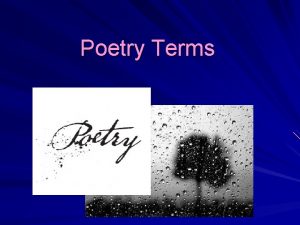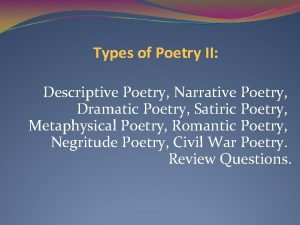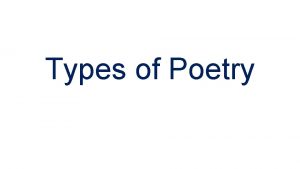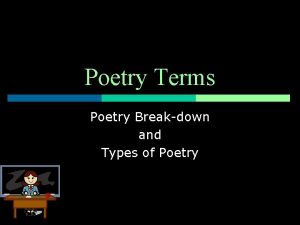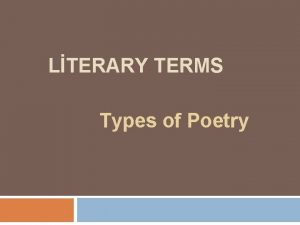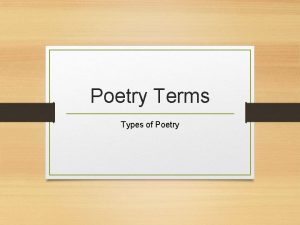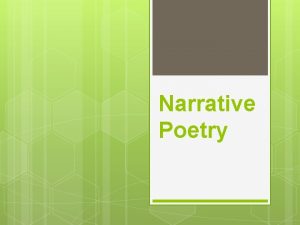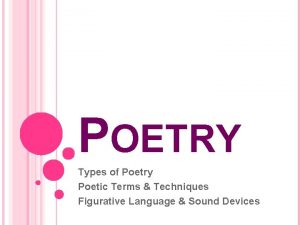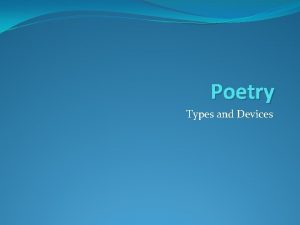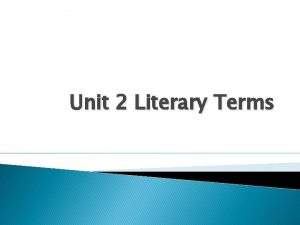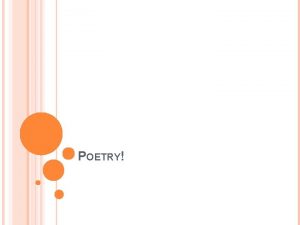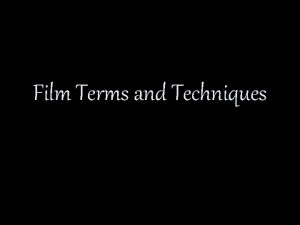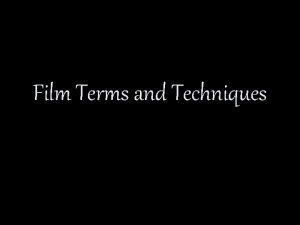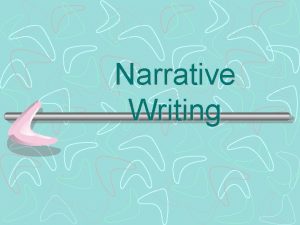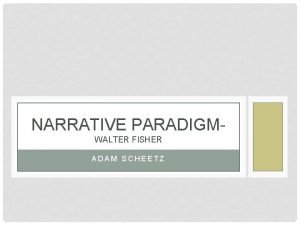Poetry Terms and Techniques Types of Poetry Narrative



































































- Slides: 67

Poetry Terms and Techniques

Types of Poetry Narrative Poetry- a narrative poem is one that tells a story. Types of narrative poetry include ballads and epics. Lyric Poetry- a highly musical verse that expresses the emotions of the speaker. Common types are sonnets, odes, free verse and elegies. Dramatic poetry- a dramatic poem is a verse that relies heavily on dramatic elements such as monologue, or dialogue. Two types of dramatic poetry are dramatic monologue and soliloquy.

Ballad: a narrative poem, sometimes sung, that tells a dramatic story.

Acrostic poem: The first letters of the lines in an spell a word, often the subject of the poem. Another very incredibly Intelligent and intuitive Xena type warrior princess teacher with An attitude. Domo arigato gozaimashita

Epic : a long narrative poem centering on a heroic figure who represents the fate of a nation. Beowulf is an Old English heroic epic poem of anonymous authorship. In the poem, Beowulf, a hero of the Geats, battles three antagonists: Grendel, Grendel's mother; and, later in life after becoming a king, an unnamed dragon.

Concrete poem is written in a shape that adds meaning to the poem.

Free verse : poetry with no set rhythm or rhyme.

Blank verse: unrhymed iambic pentameter.

Elegy or Elegiac poem: a meditative poem mourning the death of an individual.

Dramatic monologue: a poem in which a character addresses an audience. l A fictional character, at a critical or dramatic point in life, addresses a particular “audience”, which his identifiable but silent. In the course of the monologue, we learn a great deal, often ironically, about the character who is speaking and the circumstance that have led to the speech.

Soliloquy l A form of monologue found most often in drama. It differs from a dramatic monologue in that the speaker is alone, revealing thoughts and feelings to or for oneself that are intentionally unheard by other characters in Shakespeare’s plays for example the principal characters’ reflections on how to act or questions of conscience are revealed in their soliloquies. “To be or not to be…” (Shakespeare’s Hamlet)

See if you can get this clue… The next poem rhymes with the last word in the above sentence. It originated in an archipelago famous for natural disasters, especially tsunamis and earthquakes.

Haiku: a three-line poem usually about nature, with this syllable pattern: 5, 7, 5. This style originated in Japan. The old bicycle leaning against the lamp post Will it fall over?

Alright poetic geniuses… What is another poem similar to haiku but longer?

Tanka: a five-line poem usually about emotions with this syllable pattern: 5, 7, 7. The tanka poem is very similar to haiku but tanka poems have more syllables and it uses simile, metaphor and personification. There are five lines in a Tanka poem. Line one - 5 syllables Line two - 7 syllables Line three - 5 syllable Line four - 7 syllables Line five - 7 syllables Beautiful mountains Rivers with cold, cold water. White cold snow on rocks. Trees over the place with frost. White sparkly snow everywhere. Tanka poems are written about nature, seasons, love, sadness and other strong emotions. This form of poetry dates back almost 1200 years.

Ode: a meditation or celebration of a specific subject. Excerpt from ODE ON A GRECIAN URN By John Keats What leaf-fringed legend haunts about thy shape Of deities or mortals, or of both, In Tempe or the dales of Arcady? What men or gods are these? What maidens loath? What mad pursuit? What struggle to escape? What pipes and timbrels? What wild ecstasy?

Let’s see if you get this one…. ______ : a poem of fourteen lines in iambic pentameter.

Sonnet: a poem of fourteen lines in iambic pentameter. The New Colossus Not like the brazen giant of Greek fame, (a) With conquering limbs astride from land to land; (b) Here at our sea-washed, sunset gates shall stand (b) A mighty woman with a torch, whose flame (a) Is the imprisoned lightning, and her name (a) Mother of Exiles. From her beacon-hand (b) Glows world-wide welcome; her mild eyes command (b) The air-bridged harbor that twin cities frame. (a) "Keep, ancient lands, your storied pomp!" cries she (c) With silent lips. "Give me your tired, your poor, (d) Your huddled masses yearning to breathe free, (c) The wretched refuse of your teeming shore. (d) Send these, the homeless, tempest-tost to me, (c) I lift my lamp beside the golden door!" (d) Emma Lazarus, 1883

Shakespeare’s Sonnet 116 Let me not to the marriage of true minds (a) Admit impediments. Love is not love (b) Which alters when it alteration finds, (a) Or bends with the remover to remove. (b) O no, it is an ever fixed mark (c) That looks on tempests and is never shaken; (d) It is the star to every wand'ring barque, (c) Whose worth's unknown although his height be taken. (d) Love's not time's fool, though rosy lips and cheeks (e) Within his bending sickle's compass come; (f) Love alters not with his brief hours and weeks, (e) But bears it out even to the edge of doom. (f) If this be error and upon me proved, (g) I never writ, nor no man ever loved. (g)

A quick quiz: Do you know… Stanza_________ l Rhyme scheme _______ l

Stanza: grouping of lines within a poem. Rhyme: repetition of the same sound. Rhyme scheme: a regular pattern of end rhyme in a poem.

Ok, so lets now go over common FORMS OF STANZA!

What’s a couplet? Je nais se pas!

Couplet: two lines of poetry that usually rhyme. Avocado Girl By: Ms. Aixa B. Rodriguez I am an ahuacatl of ancient days, Of both past and present ways. I am an aguacate of a familiar green, A nuyorbronxrican Queen. I am an avocado with rough Bronx skin, both Latina and American.

Not bad. . How about a tercet? Or triplet?

Triplet or tercet: any three lines of poetry, whether as a stanza or as a poem, rhymed or unrhymed, metered or unmetered. I am a yellow dog who wishes he was a purple-spotted frog.

You are getting it! And now. . a quatrain?

Quatrain: four lines of poetry that usually have a rhyme scheme. l A quatrain is a poem, or a stanza within a poem, that consists always of four lines. It is the most common of all stanza forms in European poetry. The rhyming patterns include aabb, abab, abba, abcb. Example: aabb (from William Blake, "The Tyger") Tyger! burning bright In the forests of the night, What immortal hand or eye Could frame thy fearful symmetry?

A cinquain? A quintain? It’s driving me insane! You can do it! USE THE FORCE!

Cinquain: a five-line poem In summertime on Bredon The bells they sound so clear; Round both the shires they ring them In steeples far and near, A happy noise to hear. -A. E. Houseman, “Bredon Hill”

Does it ever end? l Sestet: six lines O, young Lochnivar is come out of the west, Through all the wide Border his steed was the best; And save his good broadsword he weapons had none, He rode all unarm’d, and he rode all alone. So faithful in love, and so dauntless in war. There never was knight like the young Lochnivar. - Sir Walter Scott, “Lochnivar”

Nope…. l Heptastich: seven lines The flower that smiles today Tomorrow dies; All that we wish to stay Tempts and then flies; What is this world’s delight? Lightning, that mocks the night, Brief even as bright. - Percy Bysshe Shelley, “Mutability”

Last one! I promise! l Octave: eight lines Labor is blossoming or dancing where The body is not bruised to pleasure soul, Nor beauty born out of its own despair, Nor blear-eyed wisdom out of midnight oil. O chestnut tree, great-rooted blossomer, Are you the leaf, the blossom, or the bole? O body swayed to the music, O brightening glance, How can we know the dancer from the dance? - William Butler Yeats, “Among School Children”

Quick quiz l Sestet: _____________ l Heptastich: ___________ l Octave: _____________

Ok. . now Rhythm and Rhyme! Techniques of Poetry: Sound

Rhyme l End Rhyme- the use of rhyming words at the ends of lines. l Internal rhyme: use of rhyming words within lines l Slant Rhyme- use of rhyming sounds that are similar but not identical, as in rave and rove or rot and rock. (consonance is a type of slant rhyme).

Ok, ok… how about Alliteration and consonance?

Alliteration: repetition of initial consonant sounds. Sometimes some students decide to stand instead of sitting, to speak when someone is speaking and simply act silly.

Consonance: same consonant sound Avocado Girl By: Ms. Aixa B. Rodriguez I am an ahuacatl of ancient days, Of both past and present ways. I am an aguacate of a familiar green, A nuyorbronxrican Queen. I am an avocado with rough Bronx skin, both Latina and American Americ.

Ok keep it clean… What is assonance?

Assonance: repetition of vowel sounds among words that begin or end with different consonants. "Do you like blue? ". ue How now brown cow Hear the mellow wedding bells. — Edgar Allan Poe, "The Bells"

Meter and rhythm: movement and pattern in a poem. l Metrical verse follows a set rhythmical pattern. Free verse or vers libre, does not. l The meter of a poem is its rhythmical pattern. l English verse is made of rhythmical units called feet. A foot is made up of weakly stressed (˘) ( and strongly stressed (/) syllables.

Poetry has feet? Type of Foot Pattern Example Iamb, or iambic foot ˘/ afraid Trochee, or trochaic foot /˘ freedom Anapest, or anapestic foot ˘ ˘/ in a flash Dactyl, or dactylic foot /˘˘ feverish Spondee, or spondaic foot // baseball Pyrrhee or pyrrhic foot ˘˘ unbelievable

How many feet does your poem have? Term Number of feet Example monometer one foot And I Shall fly away dimeter two feet After autumn Comes the winter trimeter three feet In the midst of mourning tetrameter four feet O saddle up my milk white steed pentameter five feet That time of year thou may’st in me behold hexameter six feet A perfect knight he was, that all could plainly see.

Iambic pentameter: ten syllables with 2 nd, 4 th 6 th, 8 th, 10 th syllables accented. l Shakespeare wrote in iambic pentameter.

Techniques of Poetry: Meaning l l l l Image- language that creates a concrete representation of an object or an experience. Objective correlative- group of images that together create a given emotion in a reader or listener. Figure of speech or trope is an expression that has more than a literal meaning. Hyperbole- an exaggeration made for rhetorical effect. Metaphor- figure of speech in which one t thing is spoken or written about as if it were another. Tenor of the metaphor is the writer’s actual subject. The vehicle of the metaphor is the other thing to which the subject is compared or likened. Personification and similes are types of metaphor.

Techniques of Poetry: Meaning cont’d Metonymy- the naming of an object associated with a thing instead of the name of the thing itself. Ex: The White House for the President, or The Crown for the King. l Simile- a comparison using like or as. l Synaesthesia- a figure of speech that combines in a single expression images related to two or more different senses. Ex. Singing light. l Synecdoche- a figure of speech in which the name of a part of something is used in place of the name of the whole or vice versa. Ex. Hired hands = laborers l

Rhetorical techniques l l l l Rhetorical techniques are extraordinary but literal use of language to achieve a particular effect. Antithesis- a rhetorical technique in which words, phrases or ideas are strongly contrasted often by repeating a grammatical structure. Ex; to err is human, to forgive divine. ” Apostrophe- rhetorical technique in which an object or person is directly addressed. Catalog- a list of people or things Chiasmus- a rhetorical technique in which the order of occurrence of words or phrases is reversed. Ex. : we can weather changes but we can’t change the weather. Parallelism- a rhetorical technique in which a writer emphasizes the equal value or weight of two or more ideas by expressing them in the same grammatical form, as in the phrase “with hope, with joy, and with love. ” Repetition- writers conscious reuse of a sound, a word, phrase sentence or other element. Rhetorical question: a question asked for effect but not meant to be answered because the answer is clear from the context.

Structure and Language in Poetry l Allegory- a narrative in prose or verse, in which abstract ideas, principles human values or states d of mind are personified. The purpose of the allegory is to illustrate the significance of the ideas by dramatizing them. Parable and fable are kinds of allegory in which a moral I illustrated in the form of a story.

Allusion l A reference to a historical event, to Biblical, mythological or literary characters and incidents with which the reader is assumed to be familiar. Allusion may , with few words, enrich or extend the meaning of a phrase or idea or image, Allusion may also be used for ironic effect. In his poem Out Rober frost expects the reader to recall from Macbeth’s final soliloquy the line “Out out brief candle “ Such expressions as “ a Herculean task” or “Achilles heel” are also forms of allusion.

Ambiguity l Denotes uncertainty of meaning. In literature and especially poetry, we speak of intentional ambiguity, the use of language and images to suggest more than one meaning at the same time.

Connotation l The feelings attitudes images and associations of a word or expression. Connotations are usually said to be “positive’ or “negative”

Denotation l That which a word actually names, identifies, or “points to” Denotation is sometimes referred to as “the dictionary definition” of a work.

Figurative Language l The intentional and imaginative use of words and comparisons that are not literal but that create original, vivid, and often unexpected images and associations.

Hyperbole l An exaggerated expression also called overstatement, for a particular effect, which may be humorous, satirical, or intensely emotional. Hyperbole is the expression of folktales and legends. l Ex. I have mountains of work to do.

Irony l In general a tone or figure of speech in which there is a discrepancy a striking difference or contradiction between what is expressed and what is meant or expected. Irony maybe used to achieve a powerful effect indir 4 ectly. In satire, for example it may be used to ridicule or criticize.

Metaphor l Form of analogy or comparison where the author finds and expresses similarity between dissimilar things.

Onomatopoeia l The use of words or phrases that sound like things to which they refer. Examples include the words meow, clink, boom, and mumble.

Oxymoron l Related to paradox, oxymoron is a figure of speech in which two contradictory or sharply contrasting terms are paired fro emphasis or ironic effect. Students favorite examples include “jumbo shrimp” and “army Intelligence. ” Poets have written of the “wise fool” “ Joyful sadness” or and “eloquent silence. ”

Paradox l An expression concept of situation whose literal statement is contradictory , yet which makes a truthful and meaningful observation. “ Less is more”

Satire l A form or style that uses elements of irony, ridicule, exaggeration , understatement, sarcasm, humor or absurdity to criticize human behavior or a society.

Simile l An expression that is a direct comparison of two things using words as like a s as if seems and appears. l “ I wandered lonely as a cloud” (William Wordsworth

Speaker l The narrative voice in a poem. Also the character who speaks in a dramatic monologue

Symbol l Anything that stands for or suggests something else.

Understatement l Expression in which something is presented as less important or significant than it really is. Understatement is often used for humorous, satiric or ironic effect. l “ He was not without imagination” (Mark Twain)

Unit Quiz Stanza: grouping of lines within a poem. 2. Rhyme: repetition of the same sound. 3. Rhyme scheme: a regular pattern of end rhyme in a poem. 4. Meter and rhythm: movement and pattern in a poem 5. Iambic pentameter: ten syllables with 2 nd, 4 th 6 th, 8 th, 10 th syllables accented. 6. Blank verse: unrhymed iambic pentameter. 7. Acrostic poem: The first letters of the lines in an spell a word, often the subject of the poem. 8. Free verse : poetry with no set rhythm or rhyme. 9. Alliteration: repetition of initial consonant sounds. 10. Consonance: same consonant sound 1.

Quiz cont’d 11. 12. 13. 14. 15. 16. 17. 18. 19. 20. 21. 22. 23. 24. Assonance: repetition of vowel sounds among words that begin or end with different consonants. Internal rhyme: pattern where words within a line rhyme with the one that ends it. Couplet: two lines of poetry that usually rhyme. Triplet or tercet: any three lines of poetry, whether as a stanza or as a poem, rhymed or unrhymed, metered or unmetered. Quatrain: four lines of poetry that usually have a rhyme scheme. Cinquain: a five-line poem, with this syllable pattern 2, 4, 6, 8, 2. Ballad: a narrative poem, sometimes sung, that tells a dramatic story. Epic : a long narrative poem centering on a heroic figure who represents the fate of a nation. Concrete poem is written in a shape that adds meaning to the poem. Elegy: a meditative poem mourning the death of an individual. Dramatic monologue: a poem in which a character addresses an audience. Haiku: a three-line poem usually about nature, with this syllable pattern: 5, 7, 5. This style originated in Japan. Tanka: a five-line poem usually about emotions with this syllable pattern: 5, 7, 7. Lyric: poems that are brief and express a powerful emotion Ode: a meditation or celebration of a specific subject.
 What is a lyrical poem
What is a lyrical poem Like terms and unlike terms in polynomials
Like terms and unlike terms in polynomials Combining like terms definition
Combining like terms definition Any poem that tells a story
Any poem that tells a story Narrative poems for kids
Narrative poems for kids Elaborate lyric poem
Elaborate lyric poem Poetry terms and examples
Poetry terms and examples Is a personal narrative fiction or nonfiction
Is a personal narrative fiction or nonfiction Difference between narrative and story
Difference between narrative and story Narrative devices
Narrative devices Discuss the narrative technique in things fall apart
Discuss the narrative technique in things fall apart Narrative writers use techniques such as
Narrative writers use techniques such as Fonctions techniques et solutions techniques
Fonctions techniques et solutions techniques Poetry lo
Poetry lo Themes and techniques in victorian poetry
Themes and techniques in victorian poetry Poetry terms with examples
Poetry terms with examples What a wonderful world figurative language
What a wonderful world figurative language Common poetic devices
Common poetic devices Poetic devices repetition examples
Poetic devices repetition examples Literary terms in poetry
Literary terms in poetry Ap poetry terms
Ap poetry terms A poison tree meaning
A poison tree meaning Poetry wordsearch
Poetry wordsearch Literary terms hyperbole
Literary terms hyperbole Features of narrative poem
Features of narrative poem Poems with literary devices highlighted
Poems with literary devices highlighted Lyrical poem examples
Lyrical poem examples Rhyme sound device examples
Rhyme sound device examples Oxymoron definition poetry
Oxymoron definition poetry Types of payment terms
Types of payment terms Narrative text types
Narrative text types Narrative writing types
Narrative writing types Types of narrative writing
Types of narrative writing Structure of legend
Structure of legend Narrative hook
Narrative hook Different types of narrators
Different types of narrators What is the purpose of the narrative text?
What is the purpose of the narrative text? Types of nonfiction genres
Types of nonfiction genres Weaving techniques
Weaving techniques Tyndallization
Tyndallization Difference between multiplexing and multiple access
Difference between multiplexing and multiple access 4 different types of printmaking
4 different types of printmaking Comparative scaling
Comparative scaling Wireframe techniques
Wireframe techniques Polymer processing techniques
Polymer processing techniques A poem a.skimming b.scanning c.extensive d.intensive
A poem a.skimming b.scanning c.extensive d.intensive Name and describe several textured sets and styles
Name and describe several textured sets and styles Types of polymerization techniques
Types of polymerization techniques Base case system evaluation
Base case system evaluation Financial modelling techniques
Financial modelling techniques Caat course
Caat course Conceit definition literature
Conceit definition literature Traditional poetry vs modern poetry
Traditional poetry vs modern poetry Augustan age characteristics
Augustan age characteristics Almond tree poem
Almond tree poem Enumerative text structure
Enumerative text structure Types of poetry notes
Types of poetry notes Haiku rhyme scheme
Haiku rhyme scheme Poetry foot
Poetry foot It is a poetic foot that has a pattern
It is a poetic foot that has a pattern Meter feet poetry
Meter feet poetry Speaker elements of poetry
Speaker elements of poetry Epic structure english
Epic structure english Formal poems
Formal poems Types of descriptive poetry
Types of descriptive poetry Types of asian poetry
Types of asian poetry Major types of poetry
Major types of poetry Dirge examples
Dirge examples





